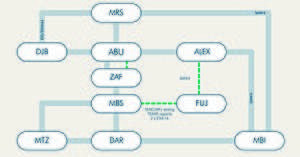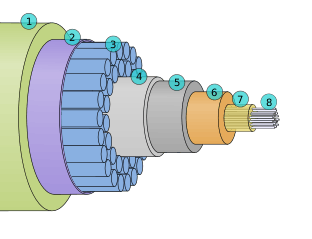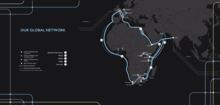SEACOM (African cable system)
SEACOM launched Africa’s first broadband submarine cable system along the continent’s Eastern and Southern coasts in 2009.
| SEACOM | |
|---|---|
 | |
| Owners: | |
| Landing points see the landing points section
| |
| Design capacity | 12 Tbit/s[2] |
| Currently lit capacity | 500 Gbit/s[3] |
| Technology | Fiber optics |
| Date of first use | July 23, 2009 |
| Website | seacom |

SEACOM is privately owned and operated.
Cable structure and technology

Fibre-optic pairs are provided from Mtunzini to France to a point of presence (PoP) in Marseille, as well as from Tanzania to India into a PoP in Mumbai.
SEACOM has also built an on-net European network, managed and operated by themselves, to deliver transport layer, internet protocol (IP), and multiprotocol label switching (MPLS) services from Africa to the following cities in Europe, and vice versa:
- Amsterdam, Netherlands
- Frankfurt, Germany
- London, United Kingdom
- Marseille, France
- Slough, United Kingdom
Through third-party networks in Europe, SEACOM also delivers these services to other locations in Europe not covered in the list of cities above.
The SEACOM cable is deployed with a mixture of double armour cable, single armour cable, special protection cable (with a metallic wrap below the insulator, rather than steel wires), and lightweight cable without armour, used in deep waters. Shallower water cable typically has more protective armour than offshore, deeper cable.
The cable is a loose tube design that determines the amount and relative location along the transmission path of each type of fibre. Multiple fibre types are used in the cable: dispersion-shifted and non-zero dispersion-shifted.
The repeaters are optical amplifier repeaters, using erbium-doped amplifiers. There are over 150 repeaters in the SEACOM system. They are spaced along the cable many tens of kilometres apart with the distance between repeaters varying depending on the segment in the system. Repeater spacing is determined by a variety of factors, including the transmission capacity of the fibres in the cable and the distance between cable landing points.
On 23 July 2009, the 17,000 kilometres (11,000 mi) cable began operations, providing the eastern and southern African countries of Djibouti, Kenya, Tanzania, Mozambique, and South Africa with high-speed Internet connectivity to Europe and Asia. The cable was officially switched on in simultaneous events held across the region, in Mombasa, Kenya, and Dar Es Salaam, Tanzania.
On 4 August 2020, SEACOM announced that it would more than double the capacity on its fibre-optic network by the end of August 2020.[4] The continent’s first broadband submarine cable system operator will add 1.7Tbit/s to its network, bringing its total capacity to 3.2Tbit/s along Africa’s eastern and Southern coasts.[4]
Project funding
SEACOM is privately-funded, and approximately 75% African-owned. Initial private investment in the SEACOM project was US$375 million: $75 million from the developers, $150 million from private South African investors, and $75 million as a commercial loan from Nedbank (South Africa). The remaining $75 million was provided by Industrial Promotion Services (IPS), which is the industrial and infrastructure arm of the Aga Khan Fund for Economic Development. The IPS investment was funded by $15 million in equity, and a total of $60.4 million in debt from the Emerging Africa Infrastructure Fund and the FMO.[5]
Current ownership structure is as follows: 30% IPS, 30% Remgro, 15% Sanlam, 15% Convergence Partners, and 10% by Brian Herlihy.[6]
The cable is variously described as a $600 and a $650 million project, and has seen a number of upgrades to landing station infrastructure, national backhaul and increases to carrying capacity, with an increase to 2.6 terabits per second (Tbit/s) in May 2012,[7] and then to 12 Tbit/s in 2014.[8]
Landing points

The cable landing points are:
- Marseille, France
- Djibouti
- Mombasa, Kenya
- Dar Es Salaam, Tanzania
- Maputo, Mozambique
- Mtunzini, South Africa
- Mumbai, India
SEACOM Partner Network landing points include:
- Yzerfontein, South Africa
- Lagos, Nigeria
- Accra, Ghana
- Fujairah, UAE
See also
- DARE (cable system)
- EASSy
- Internet in South Africa
- Main One
- TEAMS (cable system)
- WACS (cable system)
References
- "Seacom 'no comment' on FibreCo 'acquisition' talks". TechCentral (South Africa). 23 August 2018. Retrieved 14 December 2018.
- "Seacom to double capacity on surging Internet demand - TechCentral". techcentral.co.za. Retrieved 2020-08-06.
- Investment structure
- "Seacom 'no comment' on FibreCo 'acquisition' talks". TechCentral (South Africa). 23 August 2018. Retrieved 14 December 2018.
- Seacom upgrades